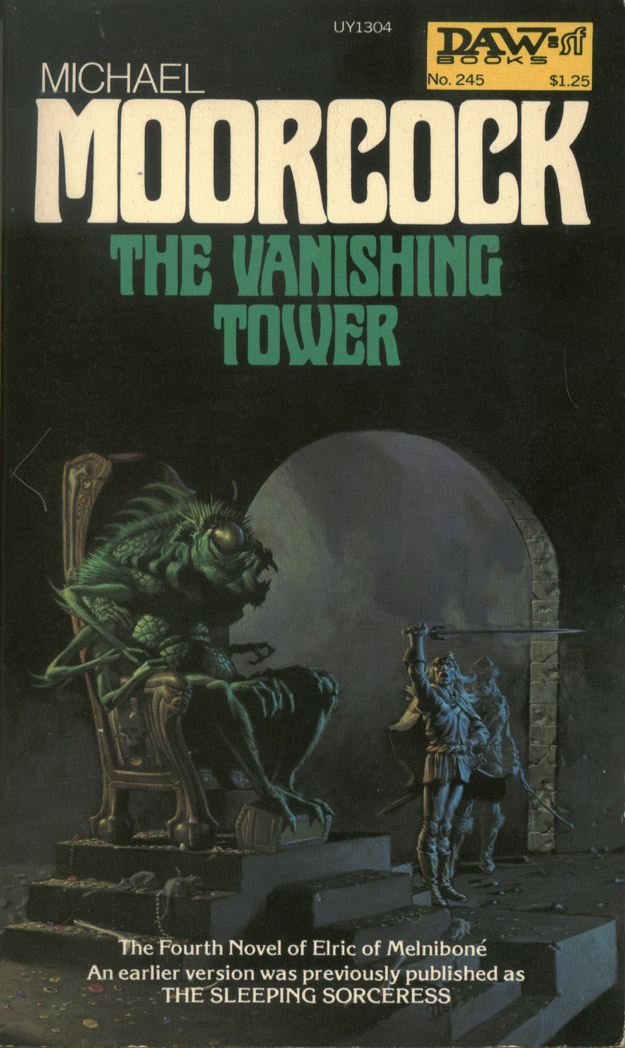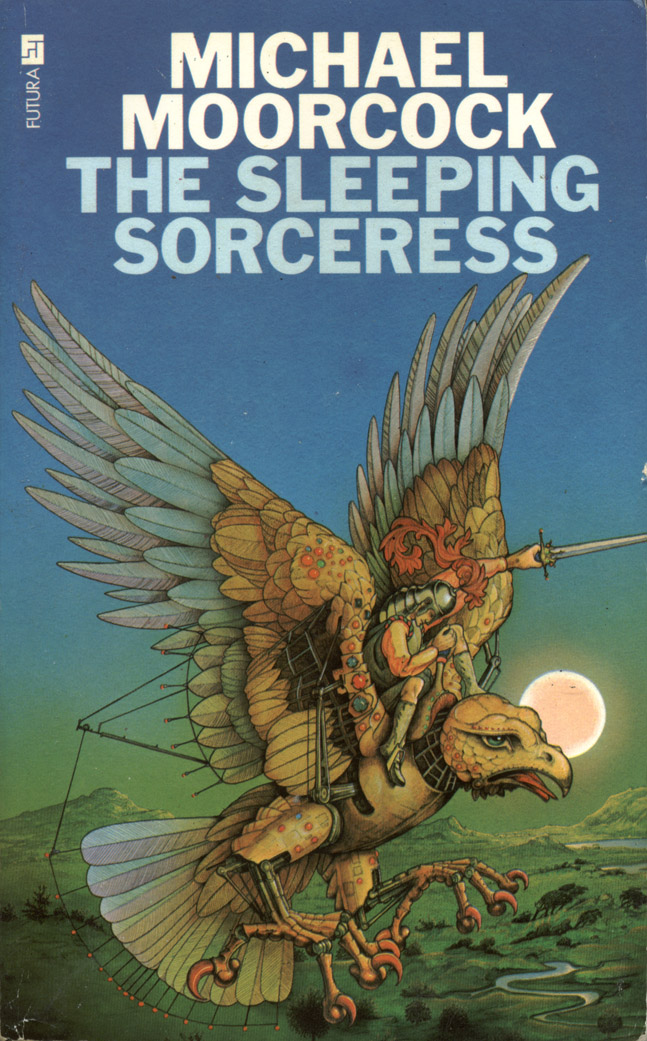Welcome back to the Elric Reread, in which I revisit one of my all-time favorite fantasy series, Michael Moorcock’s Elric saga. You can find all the posts in the series here. Today’s post discusses The Sleeping Sorceress, originally published in 1972. DAW, for reasons best known to themselves, renamed the book The Vanishing Tower, which may be the title that you recognize.
When I sat down to reread The Sleeping Sorceress for this week’s installment, I knew that I had fond memories of having read it as The Vanishing Tower back in 1989, and I’m quite sure that I enjoyed it when the Del Rey reissue came out in 2008, though perhaps I didn’t read it all that closely at the time. Now it seems to combine some of the more frustrating excesses of the Elric saga with what are, by comparison to the rest of the series, fairly conventional fantasy plots.
Like most of the other novels, it comprises three linked novellas. The first is a tale of Elric’s continuing vendetta against the evil wizard Theleb Ka’arna and his alliance against that wizard with the sorceress Myshella, Empress of the Dawn, last seen in “The Dream of Earl Aubec” spurring that hero on to claim more of the world for the forces of Law. The second sees Elric stumble into a trap hatched for him by Theleb Ka’arna and the king of Nadsokor, the City of Beggars. And the third is an explicit crossover with the Corum novel The King of Swords (to the extent that you can do a fairly amusing side-by-side reading of the relevant sections in the two books) in which Elric teams up again with Corum and Erekosë to battle a sorcerer with the jawbreaking name of Voilodion Ghagnasdiak.
 Now it’s all vividly imagined stuff, and even on a bad day the Elric books have creepily unforgettable set pieces like the Noose of Flesh, the horrible magic weapon that Myshella deploys against Theleb Ka’arna’s army. It starts out as a pink powder that she drops in a ring around her enemies, and it grows into great fleshy pink mass that crushes and then absorbs the army and its horses, leaving only bits of armor and weapons behind—Freudian nightmare fuel. Later Elric must battle the Elenoin, terrible magical creatures that resemble women with hideous sharp teeth, against whom the only recourse are the ape-like Grahluk—and it’s suggested that the Elenoin and the Grahluk might once have been the males and females of some long-forgotten species.
Now it’s all vividly imagined stuff, and even on a bad day the Elric books have creepily unforgettable set pieces like the Noose of Flesh, the horrible magic weapon that Myshella deploys against Theleb Ka’arna’s army. It starts out as a pink powder that she drops in a ring around her enemies, and it grows into great fleshy pink mass that crushes and then absorbs the army and its horses, leaving only bits of armor and weapons behind—Freudian nightmare fuel. Later Elric must battle the Elenoin, terrible magical creatures that resemble women with hideous sharp teeth, against whom the only recourse are the ape-like Grahluk—and it’s suggested that the Elenoin and the Grahluk might once have been the males and females of some long-forgotten species.
But Elric throughout this book wears his pain most ostentatiously on his sleeve, and it does become a little tiresome. In this week’s Advanced Readings in D&D series, Tim Callahan remarks that “I wouldn’t actually say I like Elric himself,” and to most readers over sixteen, the grandiose moping on display here is one of the reasons why. When Myshella offers both herself and a vision of Elric’s desires to him, he screams in terror, and on recovering himself, tells her coldly, “Know this. Elric cannot have what he desires most. What he desires does not exist. What he desires is dead. All Elric has is sorrow, guilt, malice, hatred. This is all he deserves and all he will ever desire.”
You might be forgiven, at this point, for rolling your eyes a bit and saying “oh, come on.”
I’d argue that in the novels written from The Fortress of the Pearl onward, Elric is more appealing sort of guy, but I’ll get to that in more detail in the next installment when I discuss The Revenge of the Rose. At this point, in this Elric novel written in 1972, he’s pretty thoroughly wrapped up in his own agony, coming dangerously close to self-parody. After his friend Rackhir persuades him to rest in the peaceful city of Tanelorn, he decides that he is “not meant for Tanelorn,” he decides, and rides off on a quest for adventure that might as well be an attempt at suicide by desert. At the end, having successfully defended Tanelorn against a siege at the cost of Myshella’s life, he ends up screaming at the skies “in a voice full of roaring misery and bitter rage: ‘Ah, damn you! Damn you! Damn you!’”
It’s all laid on a bit thickly. In his introduction to the Del Rey edition of The Sleeping Sorceress, Moorcock notes that he was under “considerable pressure from publishers” to deliver more adventures of his popular anti-hero, and as this was written after the actual end of Elric’s story in Stormbringer, one might perceive a little of the effect similar to that of Conan Doyle having to write about Sherlock Holmes after “The Final Problem.” By 1972, Moorcock had already moved well on to Jerry Cornelius, Corum, and other denizens of his Multiverse, so perhaps his revisiting of Elric here can be forgiven for seeming a little rote.
Significantly, in any case, this book fills in a bit more on the greater conflict between Law and Chaos that has been building to a head throughout the saga, and Elric’s own peculiar role in that conflict. On the side of Law we have Myshella, and we finally get a glimpse of one of the Lords of Law, Donblas, who rescues Elric from becoming a demon’s “roast pork.” On the side of Chaos is Elric’s patron demon, Arioch, who exhibits more than a little jealousy at Donblas’s intervention; Theleb Ka’arna, who is probably one of the most incompetent evil wizards of all time (that he keeps escaping Elric is largely due to a combination of luck and cowardice); and to a certain extent Elric himself, though Elric’s own role is growing increasingly ambiguous. In the middle are the likes of Rackhir the Red Archer, a hero of the city of Tanelorn, which serves neither Law nor Chaos—a position wrongly interpreted by another character as a refusal to take sides. The Balance is, in a way, its own “side,” as we’ll see as the saga progresses.
Up next: Elric’s father issues and a trip across the Multiverse with the poet Wheldrake and the beautiful warrior known as the Rose.
Publication Notes:
- UK Mass Market Paperback, NEL, 1972, Cover by Jan Parker
- US Mass Market Paperback, 1972, Cover by Charles Moll
- Included in The Sleeping Sorceress, vol. 3 of The Chronicles of the Last Emperor of Melniboné, Del Rey, 2008
- New edition to be published by Gollancz in The Sleeping Sorceress, due November 2013
Karin Kross lives and writes in Austin, TX. She’s saving most of her comments about Una for the Moonbeam Roads trilogy and if/when she gets around to the Jerry Cornelius books. She can be found elsewhere on Tumblr and Twitter.










